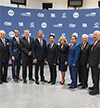Federal High-Speed Rail Plans Moving Down the Line
Winter 2012
In May 2011 the U.S. Department of Transportation (USDOT) announced $2 billion in high-speed rail investments, including $404 million for the Midwest and $795 million to improve heavily-used sections of the Northeast Corridor, which will increase train speeds from 135 to 160 miles per hour when completed.
Illinois is moving forward with important projects in the Chicago-St. Louis corridor, such as the $186 million upgrade to the Dwight-Joliet track. Construction has also started on the Englewood Flyover in Chicago, one of the nation's worst rail bottlenecks. Overhauling this outdated rail bridge will greatly reduce congestion and backups for freight and commuter travel.
The Chicago-Detroit corridor is also being upgraded. Approximately $200 million will be spent on rehabilitating track and signal systems between Kalamazoo and Dearborn, allowing trains to travel at 110 mph on a 235-mile section of the corridor, reducing travel time by about 30 minutes.
The Obama administration has also awarded $928 million to the California High-Speed Rail Authority for initial construction of California High-Speed Rail. This project is expected to create 100,000 jobs over the next five years and reduce carbon emissions by three million tons annually. Construction of the first section - the $6 billion, 130-mile segment from Bakersfield to Merced - will start this year.
In December 2011, the USDOT also awarded $7 million in High-Speed Intercity Passenger Rail funds to enhance the Southeast high-speed rail corridor, including a new service development plan and environmental study for the 250-mile corridor between Atlanta and Charlotte. The Georgia DOT also plans to construct a multimodal passenger terminal in downtown Atlanta that will be able to accommodate high-speed rail.
The U.S. rail industry is excited about these developments. In October 2011, Progress Rail Services Corp., a subsidiary of Caterpillar, opened a new American locomotive manufacturing plant in Muncie, Indiana. The $50 million, 700,000-square-foot facility will build locomotives and employ more than 150 workers. Caterpillar is an international leader in diesel engine technology and is the only company to manufacture two- and four-cycle locomotive engines.
"Progress Rail is also eligible, under `Buy America' guidelines, to bid on building our first domestically manufactured fleet of high-speed rail locomotives," comments U.S. DOT Secretary Ray LaHood. "Those same `Buy America' provisions mean that parts and supplies will also come from American manufacturers, which will mean even more jobs." Secretary LaHood further notes that "2012 is shaping up to be a year of significant high-speed rail activity," with more than $1 billion in high-speed rail construction activity under way and 32 states with construction already in progress.
"Contracts are being let around the U.S. by states for design work, planning work, construction materials, and supplies," continues LaHood. "We have 30 rail companies that have pledged to hire Americans and expand their U.S. operations if awarded contracts to work on high-speed rail. We're not just talking about adding jobs - we're talking about revitalizing the American rail manufacturing industry."
Project Announcements
Provalus Plans West Plains, Missouri, Operations
11/01/2025
Eos Energy Enterprises Expands Allegheny County, Pennsylvania, Operations
11/01/2025
Ahold Delhaize USA Plans Burlington, North Carolina, Distribution Operations
11/01/2025
Ulbrich Specialty Wire Products Expands Westminster, South Carolina, Production Operation
11/01/2025
Alcoa Expands Massena, New York, Operations
11/01/2025
SmartWiz Expands Birmingham, Alabama, Headquarters Operations
11/01/2025
Most Read
-
2025’s Top States for Business: How the Winners Are Outpacing the Rest
Q3 2025
-
The Compliance Reckoning Is Here
Q3 2025
-
Around the Horn: Data Center Supply Chains — What's Next?
Q3 2025
-
How Consumer Trends Are Reshaping Food Facilities
Q3 2025
-
First Person: Filter King’s Expansion Playbook
Q3 2025
-
Rethinking Auto Site Strategy in the Age of Tariffs and Powertrain Shifts
Q3 2025
-
How Canada Stays Competitive
Q3 2025



